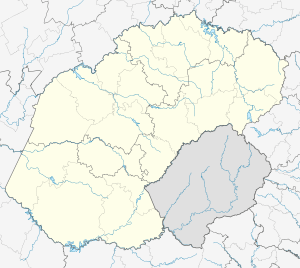Paul Roux
| Paul Roux | |
|---|---|
 Paul Roux  Paul Roux  Paul Roux
| |
| Coordinates: 28°18′S 27°57′E / 28.300°S 27.950°ECoordinates: 28°18′S 27°57′E / 28.300°S 27.950°E | |
| Country | South Africa |
| Province | Free State |
| District | Thabo Mofutsanyane |
| Municipality | Dihlabeng |
| Established | 1909 |
| Area[1] | |
| • Total | 6.6 km2 (2.5 sq mi) |
| Population (2011)[1] | |
| • Total | 6,152 |
| • Density | 930/km2 (2,400/sq mi) |
| Racial makeup (2011)[1] | |
| • Black African | 91.6% |
| • Coloured | 1.8% |
| • Indian/Asian | 0.4% |
| • White | 5.9% |
| • Other | 0.2% |
| First languages (2011)[1] | |
| • Sotho | 88.2% |
| • Afrikaans | 7.1% |
| • Sign language | 1.8% |
| • English | 1.1% |
| • Other | 1.8% |
| Postal code (street) | 9800 |
| PO box | 9800 |
| Area code | 058 |
Paul Roux is a small town in the flatlands of Free State province of South Africa that produces poplar wood for the safety match industry. General farming, however, remains the main industry. It was established in 1909 by Dutch Reform Reverend Paul Roux on the farm Palmietfontein, and today has a population of 5,722. Initially, there was dispute as to the name of the new town. The final name was decided, in a dice like fashion, by the roll of a boulder from the koppie (hill) above the town. The boulder landed face up displaying the name of the town as it is known today.
Former South African State President P. W. Botha was born in Paul Roux in 1916 on the farm Telegraaf (Telegraph).
A Boer monument is located close by next to the Sand River on the farm Tevrede (Content) for children that died from measles during the Great Trek.
During the Second Boer War of 1899-1902, the farm Witnek was occupied by the British. The farm house was converted into a hospital and the mountain pass, bearing the same name of the farm, was guarded in an effort to block the path for the famous Boer general, Christiaan de Wet.
Large, clear, dinosaur footprints left on sandstone rock can be found on the farm, Uniondale.
The farm, Zuringkranz, was a halfway house for refreshing the horses pulling the postal wagons and coaches.
In town boasts various examples of sandstone architecture. Excellent examples being the Dutch Reformed Church, local school and various other houses. Most streets remain unsurfaced and the town has a character of a time gone by.
The lokasie (township), Fateng-Tse-Ntso, a remnant of the Apartheid system, is still fully occupied by the original inhabitants and growing quickly. It boasts a new high school and library. Water supply remains a problem in the area.
The first Paul Roux in South Africa was a French Huguenot who immigrated to Cape Town in 1688. There are still many descendants of Roux in the country who continue to bear his name.
.svg.png)